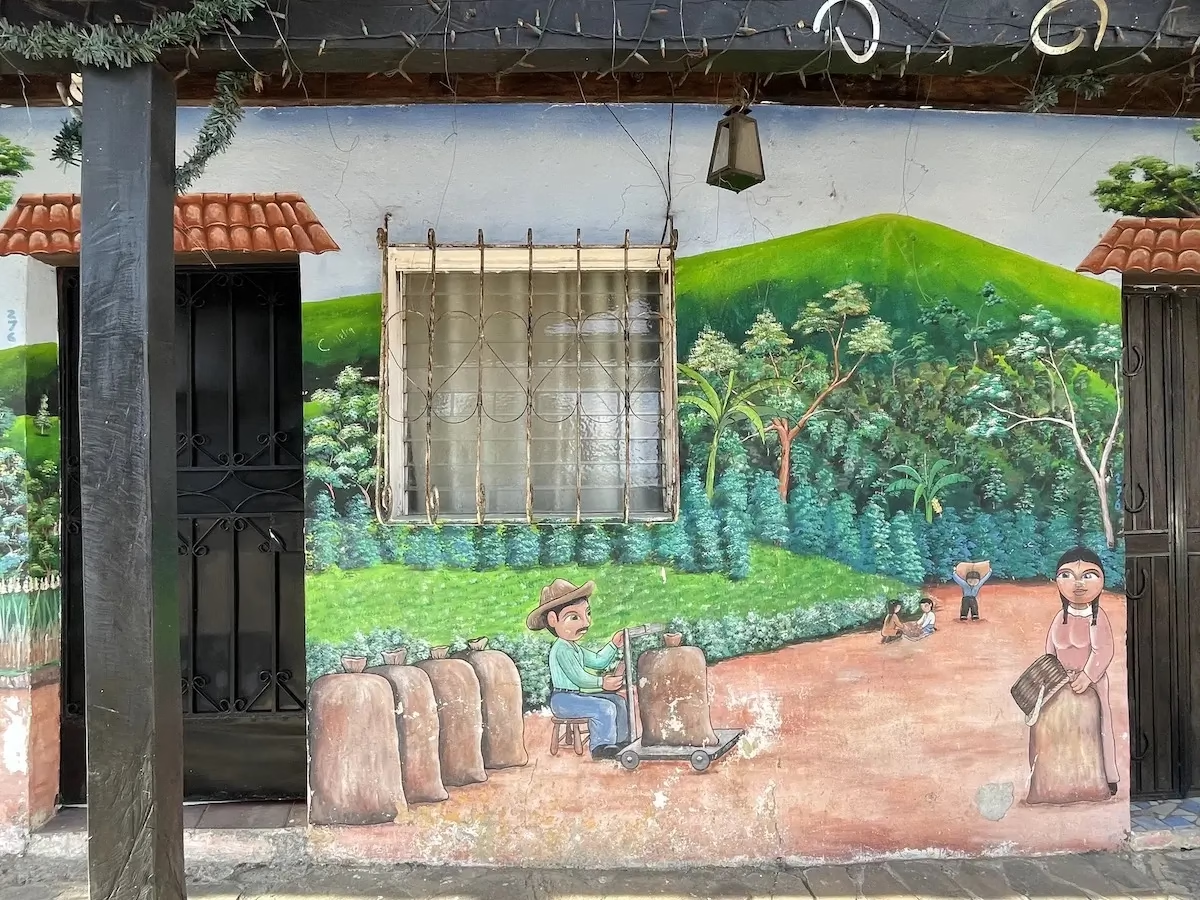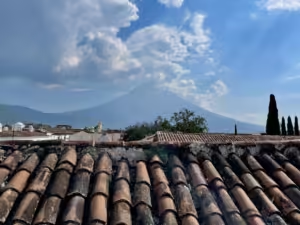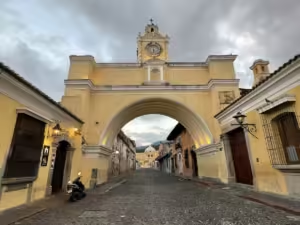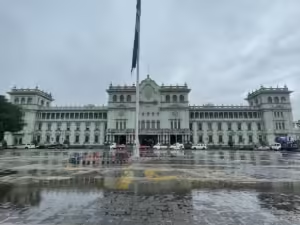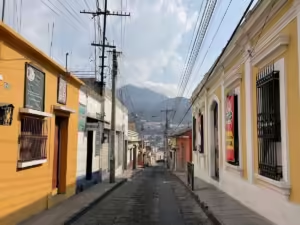La Ruta de las Flores might be my favorite part of El Salvador. It’s a collection of tranquil villages resting along a winding road that twists and turns through El Salvador’s western mountains. The climate is cool, the air is clean, the views are gorgeous and the pupusas are cooked fresh.
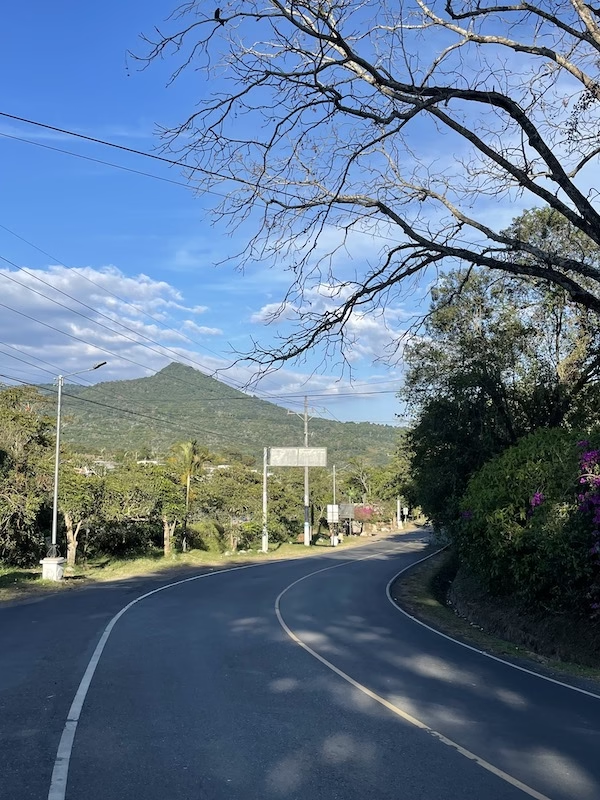
What to Know about La Ruta de las Flores
La Ruta de Las Flores, or “route of the flowers” in English, got its name from the variety of flowers that color the vegetation of the hillsides along the road. To be perfectly honest, we saw plenty of flowers, but there didn’t seem to be an excessive amount. We saw more stray dogs than flowers. I suppose, “la Ruta de los Perros” doesn’t quite have the same poetic ring to it. Maybe we just went during the wrong season.
There are six villages along La Ruta de las Flores, each one with its own feel to it. A lot of blogs and travel guides recommend renting a car and driving the route. I found the public buses to be pretty easy, though. I never felt like I was missing out on anything by not driving. Also, taking the bus is a hell of a lot cheaper than renting a car.
If you’re coming from Santa Ana, you can go to Ahuachapan and then transfer to wherever else you’re going on La Ruta. Otherwise, coming from San Salvador (and points beyond, such as El Tunco) you’ll need to transfer in Sonsonate. Salvadorans are generally very friendly, so if you get lost don’t hesitate to ask.
Some people tour the entire Ruta de las Flores on a day trip from San Salvador. I think that’s a terrible idea. Give yourself a few days to leisurely explore and ease yourself into the tranquil pace of village life. Distances between towns along the route are short enough that you can easily base yourself in one spot and take day trips to explore the other villages.
El Salvador is in the tropics, and the villages along the Ruta de Las Flores are all at higher altitude than other parts of the country. While the altitude keeps things cooler, the sun is much more intense. Don’t forget a hat and some sunscreen.
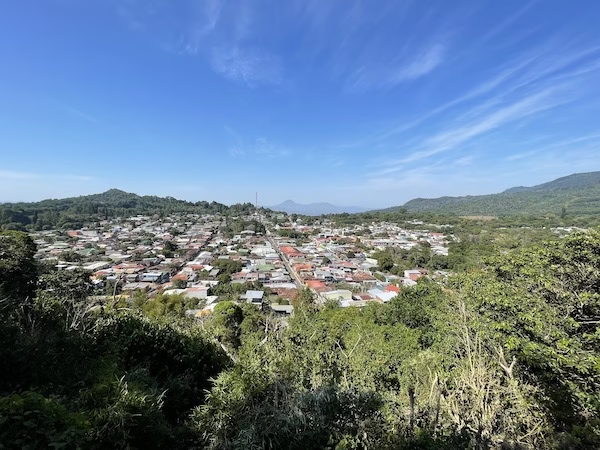
A Brief Guide to the Towns on La Ruta de las Flores
There are six main villages along La Ruta de las Flores. Each one is a little bit different than the next. Again, nothing is particularly far away, so don’t stress about staying in the ‘right’ town. You can’t really go wrong. That being said, I’m listing the towns along La Ruta de las Flores in order of my favorite to least favorite.
On one of the most fun, but also most stressful, aspects of travel is finding and booking places to stay. These days you have options ranging from dirt cheap hostel dorms to luxurious White Lotus style resorts. Thankfully, the internet is here to make finding accommodation easier.
Hostelworld is the go to app for finding hostels. For everything else, there’s Booking.com. If you book through either of the previous links, I’ll gain a small commission at no extra cost to you.
Concepción de Ataco
Concepción de Ataco was easily my favorite town along La Ruta de las Flores. The town has a amiable charm that’s friendly but not too touristy. Also, there’s a wonderful little restaurant called “A La Vista Lupita” which had some of the best pupusas in all of El Salvador. We also became pals with the local fruit vendor and got to eat a ton of delicious, fresh fruit from the market.
Ataco is home to a very lovely coffee plantation that does tours for a very reasonable price. The village itself is also one of the most colorful, with brightly painted buildings and a lot of beautiful murals. The town has a bit of a rundown feeling in parts, but I think that adds to the charm. It’s a nice place to wander around and soak in the scenery.
Aside from that, there isn’t all that much else to do in Concepción de Ataco. That’s kind of the whole point. It’s a relaxed, low-stress little highland town and it’s a great place to base yourself along the Ruta de las Flores.
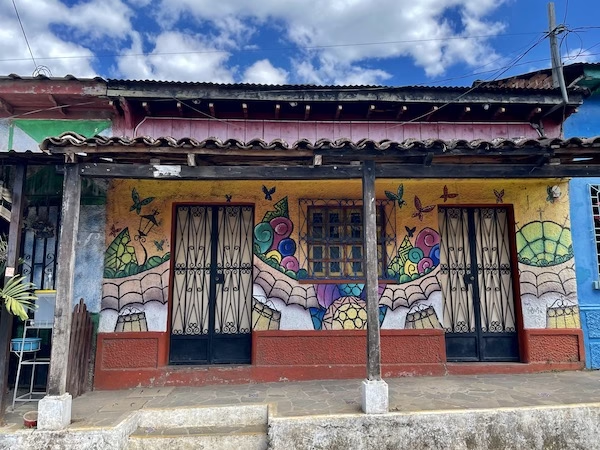
Juayua
It seems like most other travelers skip Ataco and stay in Juayua. We had time, so we stayed in both. Juayua was nice, but it just lacked that certain je ne se quoi that made Ataco so appealing. For me anyway.
Juayua definitely has more of a “backpacker” vibe. It wasn’t as swamped with tourists as other parts of Central America, but it was by far the most touristy town on La Ruta de las Flores. It was the only place where we ran into other gringos.
The village itself is maybe a bit more well put together and instantly Instagramable than Ataco. The church is bigger, too, so there’s that. Those could be pluses or minuses depending on your point of view.
That’s not to say it isn’t a lovely town. There’s also a lot more to do in Juayua than in some of the other villages. The town is known for its weekly gastronomic fair, which is a great place to try local food. It’s also the base for the fun, but dangerous, seven waterfalls hike. Juayua could be a good alternative if you want a little more action than Ataco.
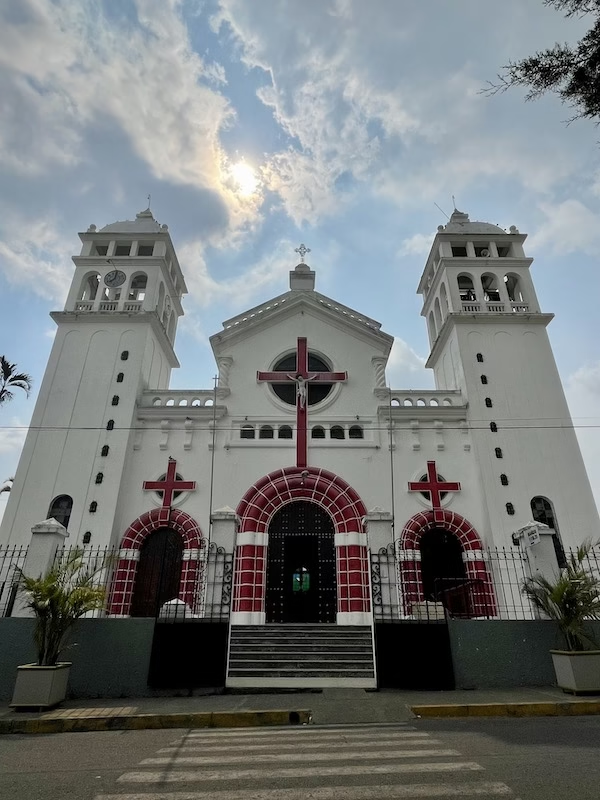
Apaneca
Apaneca is a very tiny, very cute little town. The place was almost empty when we visited during a week day, but there were wide cobble stone streets, a colonial church and a ‘Ratatouille’ themed coffee shop. What more do you need?
Apaneca is also home to the famous Café Albania, which I felt was a bit overrated, but that’s just me. There also weren’t any hotels or places to stay, as far as I could tell, but that may change as tourism in El Salvador increases. Overall, I think Apaneca is worth an afternoon’s stroll.
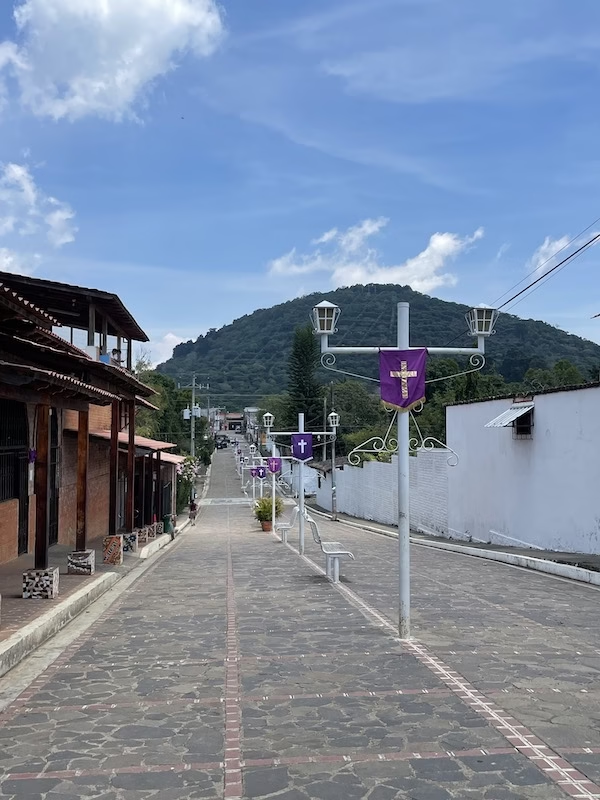
Ahuachapan
Ahauchapan is the largest town along the Ruta de las Flores. To be honest, the hustle and bustle here felt a little overwhelming in comparison to the other villages. The streets are dusty and there was actually traffic. Ahuachapan was also significantly hotter than elsewhere.
However, the town center has a lovely cathedral and a very pretty gazebo in the central park. The surrounding dirt roads are full of handsome views if you can handle wandering in the heat. You can also visit nearby volcanic geysers and fumaroles. It’s a good town for fans of geothermal activity.
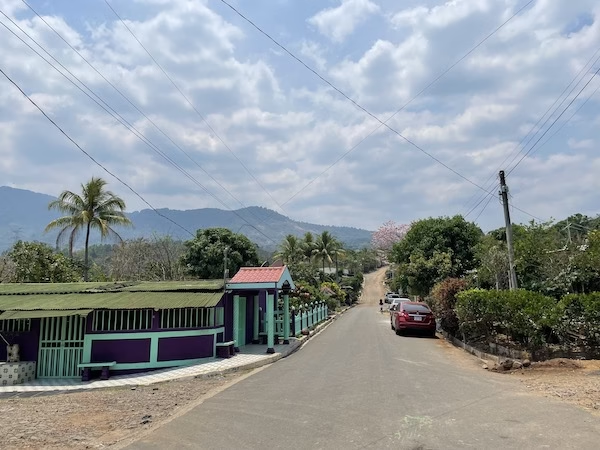
Salcoatitan and Nahuizalco
Okay, I will be honest, I didn’t visit Salcoatitan or Nahuizalco. We just simply didn’t have time. The descriptions on wikivoyage make them seem pretty nice. Who knows? Maybe I missed out on a life changing travel experience? If there’s one thing I’ve learned while traveling, though, it’s that you can’t see everything. I’ll save these two villages for next time.
Where to Stay in La Ruta de Las Flores
Being one of El Salvador’s premier tourist attractions, there are any number of reasonably priced hotels and hostels along La Ruta de Las Flores. Outside of Juayua, however, most are geared towards Salvadoran travelers. Don’t let that put you off, but don’t expect much English. Below are my two personal recommendations. If you book using any of the following links, I’ll get a small percentage at no cost to you.
The awkwardly named Casa Pino, Tu Casa en Ataco, is easily my favorite place to stay in Ataco. It might be one of the best places I’ve stayed anywhere. For the price of a hotel room elsewhere, you basically get an entire apartment to yourself. It’s an adorable building, too, and is a lovely place to share a cup of coffee or beer with your sweetheart.
If you’re staying in Juayua, we had decent luck with Mixtepek. It’s nothing fancy, but the place was clean, walking distance to town and helped out booking our seven waterfalls tour.
Click here to book Casa Pino, Tu Casa en Ataco
Things to Do in La Ruta de las Flores
The main thing to do along La Ruta de las Flores is to just wander around the different towns and take in the scenery. While Concepción de Ataco was by far my favorite, each other town we visited was still pretty in its own right. La Ruta de las Flores is the perfect place to slow down and smell the flowers, so to speak.
My only major disappointment (aside from the labyrinth) was the lack of hiking trails. The hills surrounding the road and the villages looked so green and luscious, they seemed to be begging to be hiked. But I couldn’t find any information about any hiking trails. El Imposible national park looked close on the map, but the park entrance ended up being unreachable for us. Maybe I just didn’t look hard enough.
Aside from meandering around, there are a few other activities along La Ruta de las Flores that are definitely worthwhile.
For those anxious control freaks who absolutely need to plan everything in advance: may I suggest Get Your Guide for booking tours? They’re generally cheaper than online alternatives and offer a wide range of activities. If you book through the following link, I’ll get a small commission at no cost to you and you’ll gain the satisfaction of supporting an independent travel blog. Click here to explore tours in El Salvador.
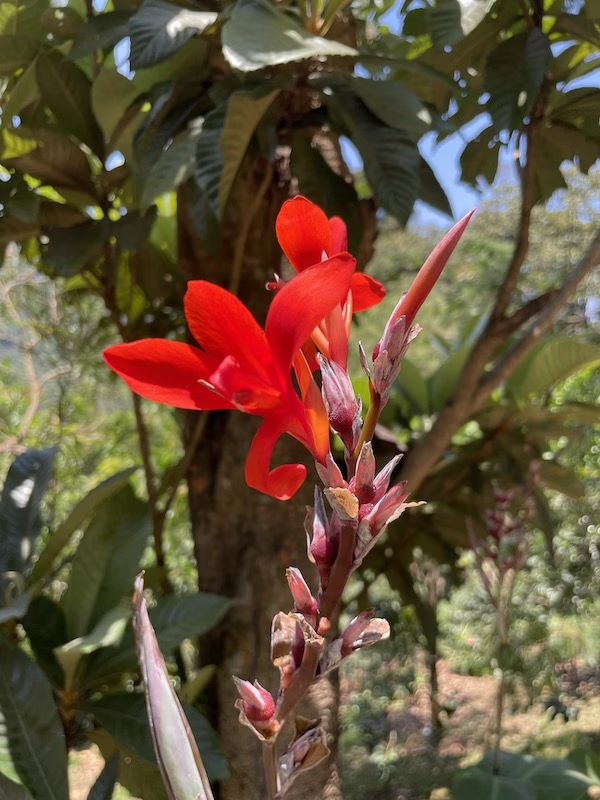
Tour a Coffee Plantation
Coffee was once the caffeinated fuel that powered the engine of El Salvador’s economy. Even today, the country is known for producing delicious beans. The cool highland climate and volcanic soil along the Ruta de las Flores make for excellent coffee growing conditions. It’s also an excellent place to take a tour and learn about the coffee growing process.
El Carmen Estate is probably the most popular place for a coffee tour. That’s where we went, encouraged by the fact that it was only a short walk from our hotel in Ataco. The tours are reasonably priced, ranging from $6 to $25 dollars depending on how intensive of a tour you want. We missed the harvest season, but it was still cool to see how coffee is grown and processed. Also, because nobody else signed up, we essentially got a private tour. And a free cup of coffee at the end, of course.
You find more information on El Carmen’s website: http://elcarmenstate-hotel.guestcentric.net/en/hotel-services.html They’re also a hotel, but while the rooms looked nice, they were well out of our budget. The coffee tour, however, was affordable and totally worth it for anyone with the slightest interest in coffee.
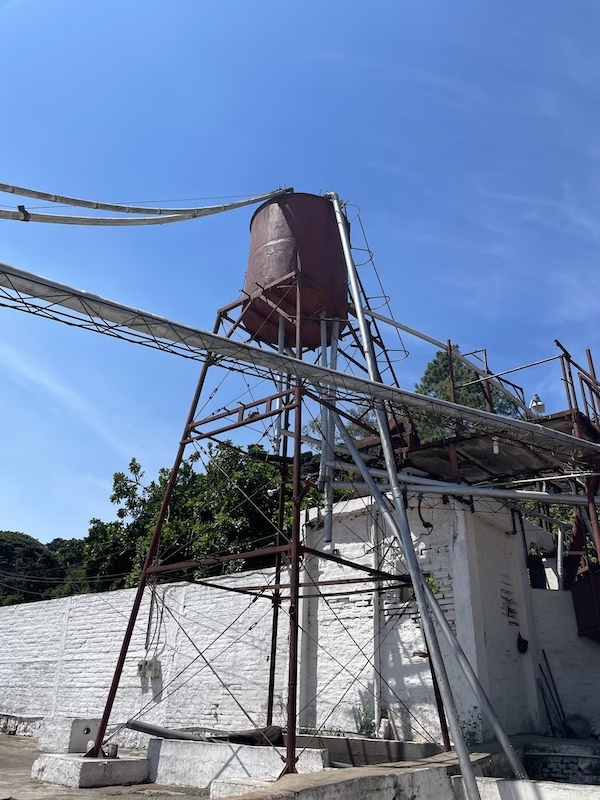
Hike Las Siete Cascadas
The verdant hills along the Ruta de las Flores hide more than flowers and coffee plantations. There are numerous waterfalls gushing down. Some you can visit. Join the Siete Cascadas (or “seven waterfalls”) hike to get up and personal with some of these gushing falls.
We actually visited ten waterfalls during our hike. Ten waterfalls for the price of seven. We organized the tour through our hostel. The guide was just a local woman accompanied by her ten-year-old son. They picked us up in the morning and took us to the trail head in the back of an old pickup.
We hiked along, past some flowering coffee plants and through the forested hills, stopping at waterfalls and taking pictures along with a group of six others. Then, at one point, we had to rappel up a twisted, fraying rope. The ten-year-old went first. Later, the trail passed directly under a torrential waterfall on a path that was no more than a few inches wide. Water was pounding down on us, as if it were trying to push us off the narrow path and down the steep cliff. We made it, but my wife almost lost her glasses.
At the end of the hike, we came across another tour group. They were wearing helmets and were outfitted with harnesses and climbing gear. It made all of us in our group wonder if we’d perhaps trusted a bit too much to luck and the climbing skills of a ten-year-old boy. We had fun, at least.
Being that this is a waterfall tour, if you decide to risk it you will get wet. Wear your swim suit on the hike and don’t assume, like I did, that you’d somehow be able to change along the way. Also bring a pair of grippy shoes you don’t mind getting wet. And a dry bag for your phone and anything else you don’t want soaked.
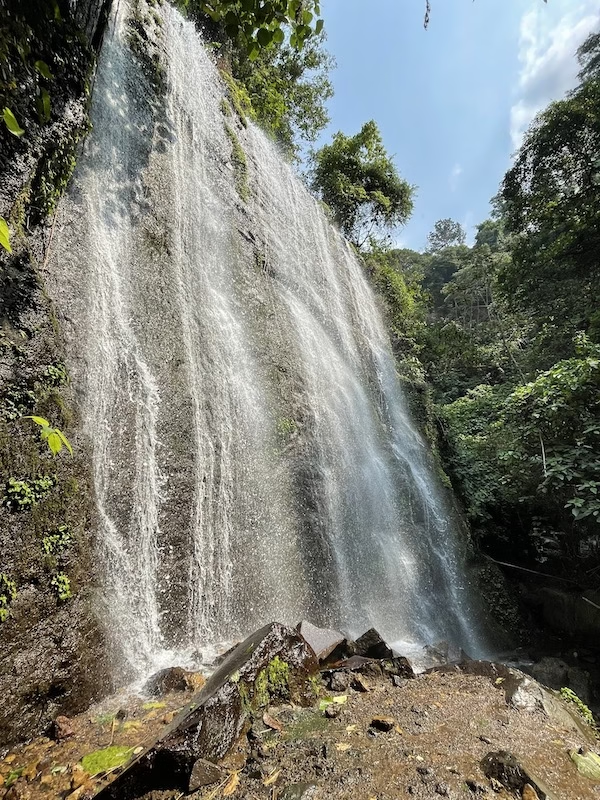
Eat Local Dishes at the Juayua Food Fair
Every week the central park of Juayua hosts a gastronomic fair. Dozens of local vendors come and sell plates of cheap local food. We had pupusas and yuca con chicharron. There were also plenty of drinks and even a guy walking around charging people to take pictures with a snake.
We didn’t spend much time at the fair, I’m afraid, since we’d just finished the waterfall hike and were pretty tired. Also, my wife is afraid of snakes, and she couldn’t abide a man walking around with a boa constrictor on his shoulders.
The food fair takes place in Juayua’s central park on weekends.
Smell the Sulfur at Los Ausoles
A local recommended Los Ausoles to us. I thought he was being friendly and helpful, but in hindsight, I think he might have been trying to kill us.
Los Ausoles is a group of volcanic fumaroles and geysers. You can walk around and watch the steam burst from the ground. The area smells of sulfur, and the area has that sort of otherworldly quality you only get around volcanic activity. It’s cool, but not necessarily a must see.
Also, there are no guardrails, trails or signs. You’re free to walk around and accidentally step on a geyser or fall into a pool of sulfuric mud, should you so desire.
If you want to risk it, Los Ausoles is located just outside of Ahuachapan. We spent what felt like hours wandering under the hot sun trying to find the place, and I couldn’t tell you how to get there even now. We were looking for some kind of signage or a park area which didn’t exist. Los Ausoles is literally just in some lady’s back yard.
She was a very nice lady, though. If wandering around geothermal activity without any safety mechanisms appeals to you, I wish you the best of luck finding the place.
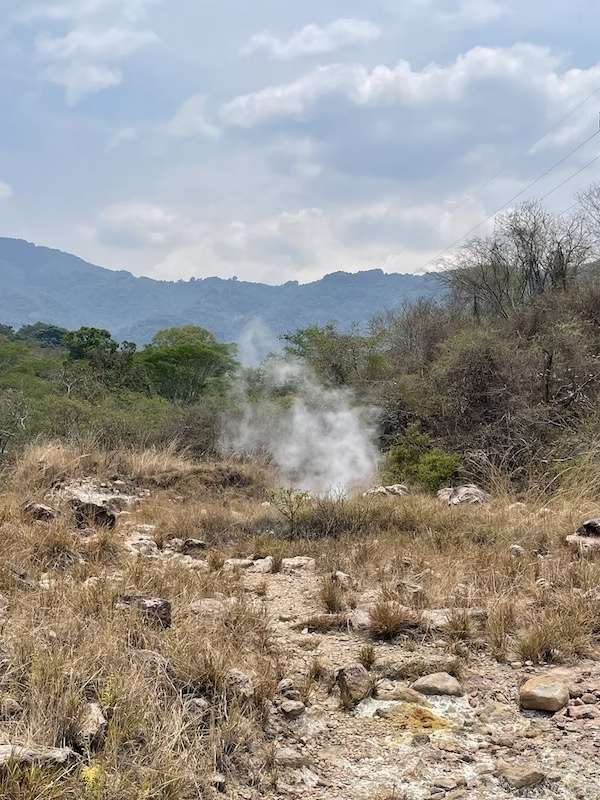
Shrug Your Shoulders at Café Albania
Most other travel blogs, as well as a few locals, recommended visiting Café Albania and especially the labyrinth. We spent an afternoon there and left with an overwhelming feeling of “meh”.
Café Albania is a big tourist complex on the side of a hill. Aside from the labyrinth, there’s also ziplining and a slide and some other things like that. It reminded me a little of Hobbitenango near Antigua but without the Middle-Earth theme.
The whole thing felt tacky to me. The views were nice, but I’d prefer a set of hiking trails to ziplines or giant slides. The labyrinth was basically just a big hedge maze. It’s where I learned that I don’t like hedge mazes.
If you’re a hedge maze fan, you can visit Café Albania just outside of Apaneca. The best part of the visit, in my opinion, was the horchata included in the cost of admission.
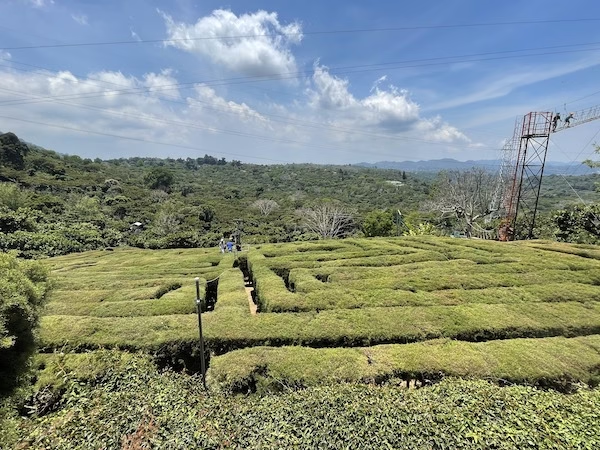
Aside from that slightly disappointing afternoon, La Ruta de las Flores remains a major highlight of my travels in El Salvador. The charming towns, the friendly locals, the beautiful scenery. It’s just a lovely, relaxed, slow paced sort of place where you can forget your troubles and just breath in the mountain air. Don’t forget your allergy medication in case the flowers are in bloom.
If you want more about El Salvador, check out our guide here: Exploring El Salvador: Central America’s Hidden Travel Gem is Ready to Shine
Useful Websites for Traveling El Salvador
As much as we might long for the days when you could show up to a town with nothing more than a beat-up guidebook and a sense of adventure, today much of traveling involves being glued to our phones making bookings. I’ve compiled some helpful apps and websites below that at least help make those bookings more convenient so you can spend less time staring at your phone and more time exploring at your surroundings. Some of these sites are affiliate links that give me a small commission at no cost to you if you chose to book through them. All of them are sites I’ve used personally and have no problem recommending.
Just be sure to do your due diligence as much as possible. Only hire local guides and try as much as possible to stay in locally owned hotels and hostels so that your hard earned travel dollars actually go to support the local economies of the places you visit.
Booking.com is basically the world’s only hotel booking website. They have hotels, guesthouses and vacation rentals all over El Salvador.
Hostelworld is the go-to site for booking hostels. If dorm rooms and shared bathrooms are your thing, you’ll find hostels all over El Salvador.
Get Your Guide offers tours and activities all around the world. Unlike some other sites and apps that do the same thing, you can actually find some reasonably priced deals here.
Centro Coasting is a great website to look up bus routes and times throughout Central America. Schedules change regularly, and the site is sometimes not as up to date as you’d like. However, it’s a good resource to help give you an idea when the buses leave, or at least get you to the right terminal.

